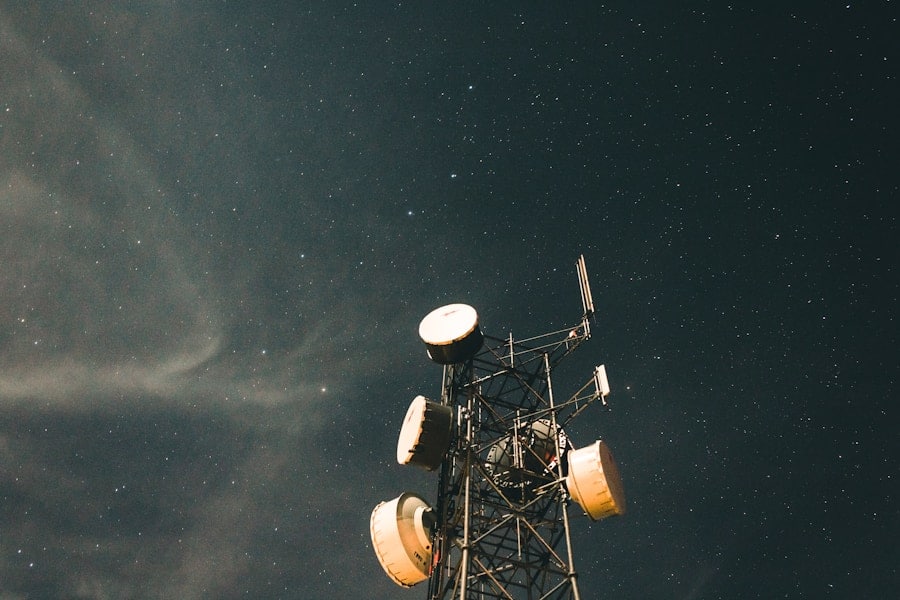The advent of artificial intelligence (AI) has revolutionized numerous sectors, and space-based communications is no exception. As humanity embarks on ambitious interstellar missions, the integration of AI into communication systems becomes increasingly vital. Space-based communications involve the transmission of data between spacecraft and Earth, as well as between different spacecraft.
The challenges posed by vast distances, signal degradation, and the need for real-time data processing necessitate advanced technological solutions. AI offers a promising avenue for enhancing these systems, enabling more efficient data handling, improved decision-making, and autonomous operations. AI’s role in space communications extends beyond mere data transmission; it encompasses the entire lifecycle of space missions.
From the planning stages to real-time operations and post-mission analysis, AI can optimize various processes. For instance, machine learning algorithms can analyze historical data to predict communication patterns and optimize bandwidth usage. Furthermore, AI can facilitate autonomous decision-making in spacecraft, allowing them to adapt to unforeseen circumstances without waiting for instructions from Earth.
This capability is particularly crucial for interstellar missions, where communication delays can span several minutes or even hours.
Key Takeaways
- AI is revolutionizing space-based communications by enabling autonomous decision-making and enhancing data processing capabilities.
- Advancements in AI are crucial for interstellar missions as they can improve navigation, communication, and data analysis in the vastness of space.
- Challenges and limitations of AI in space-based communications include the need for robust algorithms, potential cybersecurity threats, and the risk of AI malfunctions.
- Integration of AI with space-based communication systems can optimize resource management, enhance signal processing, and enable predictive maintenance.
- Potential applications of AI in interstellar missions include autonomous spacecraft operation, adaptive communication systems, and advanced data analysis for scientific research.
Advancements in AI for Interstellar Missions
Image Recognition and Analysis
One notable development is the use of deep learning algorithms for image recognition and analysis. Spacecraft equipped with advanced imaging systems can capture vast amounts of data, including high-resolution images of planetary surfaces. AI algorithms can process these images in real-time, identifying geological features, potential landing sites, and even signs of past or present life. For example, NASA’s Mars Perseverance rover employs AI to autonomously select targets for its scientific instruments, streamlining the exploration process.
Intuitive Human-Computer Interactions
Moreover, AI has made strides in natural language processing (NLP), enabling more intuitive human-computer interactions. This capability is essential for mission control teams that need to communicate effectively with spacecraft operating far from Earth. By utilizing NLP, operators can issue commands in natural language, which AI systems can interpret and execute. This advancement not only simplifies communication but also reduces the likelihood of errors that could arise from misinterpretation of technical commands.
Enhancing Interstellar Missions
As interstellar missions become more complex, such advancements will be crucial for maintaining effective communication between humans and machines.
Challenges and Limitations of AI in Space-Based Communications

Despite the promising advancements in AI for space-based communications, several challenges and limitations persist. One significant hurdle is the reliability of AI systems in the harsh environment of space. Spacecraft are subjected to extreme temperatures, radiation, and microgravity conditions that can affect the performance of electronic components.
Ensuring that AI algorithms function correctly under these conditions is paramount. For instance, radiation can cause bit flips in memory storage, potentially leading to erroneous data processing or decision-making by AI systems. Another challenge lies in the vast distances involved in interstellar communication.
The time it takes for signals to travel between Earth and distant spacecraft can lead to significant delays in data transmission. This latency complicates real-time decision-making processes that rely on immediate feedback from Earth-based operators. While AI can help mitigate some of these issues through autonomous operations, there remains a need for robust algorithms that can function effectively without constant human oversight.
Developing such systems requires extensive testing and validation to ensure they can handle unexpected scenarios autonomously.
Integration of AI with Space-Based Communication Systems
The integration of AI into existing space-based communication systems is a multifaceted endeavor that involves both hardware and software components. On the hardware side, spacecraft must be equipped with advanced sensors and processing units capable of handling complex AI algorithms. These components must be designed to withstand the rigors of space travel while providing sufficient computational power for real-time data analysis.
For example, the European Space Agency’s BepiColombo mission to Mercury incorporates advanced onboard processing capabilities to facilitate autonomous navigation and data collection. On the software side, developing AI algorithms that can seamlessly integrate with existing communication protocols is essential. This integration allows for efficient data transmission and processing while ensuring compatibility with legacy systems.
Machine learning models must be trained on diverse datasets to ensure they can adapt to various communication scenarios encountered during interstellar missions. Additionally, establishing robust cybersecurity measures is critical to protect these systems from potential threats, as vulnerabilities could compromise mission integrity.
Potential Applications of AI in Interstellar Missions
The potential applications of AI in interstellar missions are vast and varied, encompassing everything from navigation to scientific research. One prominent application is autonomous navigation, where AI systems can analyze sensor data to determine optimal flight paths and make real-time adjustments based on environmental conditions. For instance, during a mission to explore a distant exoplanet, an AI-driven spacecraft could autonomously navigate through asteroid fields or gravitational anomalies without requiring constant input from mission control.
Another significant application lies in scientific data analysis. Interstellar missions generate enormous amounts of data that require efficient processing to extract meaningful insights. AI algorithms can sift through this data, identifying patterns and anomalies that may indicate the presence of interesting phenomena or resources.
For example, during a mission to study the atmospheres of exoplanets, AI could analyze spectroscopic data to detect chemical signatures indicative of life or habitability. This capability not only accelerates scientific discovery but also enhances our understanding of the universe.
Ethical and Legal Considerations of AI in Space-Based Communications

As AI becomes increasingly integrated into space-based communications, ethical and legal considerations must be addressed to ensure responsible use. One primary concern revolves around decision-making autonomy in spacecraft. As AI systems gain the ability to make critical decisions without human intervention, questions arise regarding accountability and responsibility for those decisions.
In scenarios where an autonomous spacecraft encounters an unexpected situation—such as a collision risk—determining who is liable for any resulting consequences becomes complex. Additionally, the deployment of AI in space raises concerns about data privacy and security. Space missions often involve collecting sensitive information about celestial bodies and potential extraterrestrial life forms.
Ensuring that this data is handled responsibly and securely is paramount to prevent misuse or unauthorized access. Furthermore, as nations increasingly invest in space exploration, establishing international regulations governing the use of AI in space becomes essential to prevent conflicts and promote collaboration among countries.
Future Developments and Innovations in AI for Interstellar Missions
Looking ahead, the future of AI in interstellar missions promises exciting developments and innovations that could further enhance our capabilities in space exploration. One area ripe for advancement is the development of more sophisticated machine learning algorithms capable of self-improvement through experience. These algorithms could learn from past missions and adapt their strategies based on successes and failures, leading to more efficient operations over time.
Another promising avenue involves the integration of quantum computing with AI for space applications. Quantum computers have the potential to process vast amounts of data at unprecedented speeds, enabling real-time analysis of complex datasets generated during interstellar missions. This capability could revolutionize our approach to scientific discovery by allowing researchers to explore multiple hypotheses simultaneously rather than sequentially.
The Role of AI in Shaping the Future of Space-Based Communications for Interstellar Missions
As we stand on the brink of a new era in space exploration, artificial intelligence emerges as a pivotal force shaping the future of space-based communications for interstellar missions. The advancements made thus far demonstrate the potential for AI to enhance navigation, data analysis, and autonomous decision-making capabilities in spacecraft operating far beyond our planet. However, addressing the challenges and ethical considerations associated with these technologies will be crucial as we venture into uncharted territories.
The integration of AI into space communications not only promises to improve mission efficiency but also opens up new avenues for scientific discovery that were previously unimaginable. As we continue to push the boundaries of exploration, harnessing the power of AI will be essential for unlocking the mysteries of our universe and ensuring that humanity remains at the forefront of interstellar exploration efforts.
In a recent article discussing the future of AI in space-based communications for interstellar missions, it is fascinating to consider how technology continues to advance at a rapid pace. This progress is evident in the features of the Samsung Galaxy Book Odyssey, as explored in this article.
Additionally, the iPhone 14 Pro promises to deliver an exceptional user experience, demonstrating the ongoing innovation in mobile technology and its potential impact on future space missions.
FAQs
What is AI in space-based communications for interstellar missions?
AI in space-based communications for interstellar missions refers to the use of artificial intelligence technology to enhance and optimize communication systems for spacecraft traveling beyond our solar system. This includes the use of AI for data processing, signal optimization, and autonomous decision-making in communication processes.
How does AI benefit space-based communications for interstellar missions?
AI can benefit space-based communications for interstellar missions in several ways, including improving data transmission efficiency, reducing communication delays, and enabling autonomous decision-making in response to unexpected events. AI can also help in analyzing and interpreting large volumes of data collected from deep space, enabling more effective communication with distant spacecraft.
What are some potential applications of AI in space-based communications for interstellar missions?
Potential applications of AI in space-based communications for interstellar missions include autonomous signal processing, adaptive communication protocols, predictive maintenance for communication systems, and intelligent routing of data through interstellar space. AI can also be used for real-time analysis of communication signals to detect and correct errors, as well as for optimizing the use of available communication resources.
What are the challenges of implementing AI in space-based communications for interstellar missions?
Challenges of implementing AI in space-based communications for interstellar missions include the need for robust and reliable AI algorithms that can operate in the harsh conditions of deep space, as well as the requirement for advanced hardware and software systems to support AI-based communication processes. Additionally, ensuring the security and resilience of AI-enabled communication systems against potential threats and interference is a significant challenge.
What is the future outlook for AI in space-based communications for interstellar missions?
The future outlook for AI in space-based communications for interstellar missions is promising, with ongoing research and development efforts focused on advancing AI technologies for deep space communication. As interstellar missions become a reality, AI is expected to play a crucial role in enabling efficient and reliable communication with spacecraft traveling to distant star systems. Continued innovation in AI and space communication technologies is likely to drive further advancements in this field.

